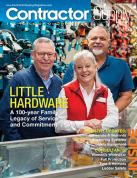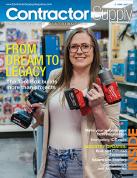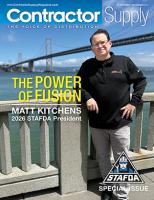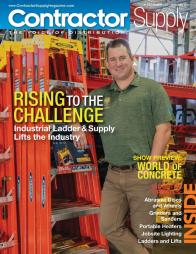Applications: Tips for Hot Weather Concreting
Sakrete's Dirk Tharpe shares tips for smaller projects.
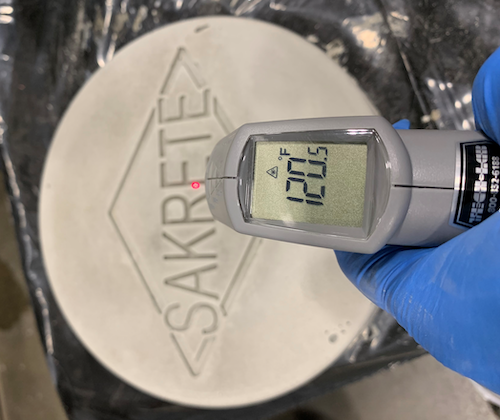 Here are some factors and considerations concrete contractors should be aware of for placing concrete or performing concrete repair in hot weather.
Here are some factors and considerations concrete contractors should be aware of for placing concrete or performing concrete repair in hot weather.
There have been scores of articles written about the challenges involving ready-mixed concrete placement when faced with hot weather. This article will focus on hot weather concreting tips and best practices for those smaller projects utilizing bagged concrete or concrete repair materials. Our focus is to help concrete contractors and do-it-yourselfers alike to employ the right hot-weather concreting precautions and practices for any given year.
According to the American Concrete Institute (ACI), any time the ambient temperature exceeds 77 degrees Fahrenheit (25 degrees Celsius), a hot weather plan for concreting should be in place. The ACI also sets the maximum temperature for plastic concrete as 95 degrees Fahrenheit (35 degrees Celsius).
Let us review some of the adverse conditions present in Hot Weather Concreting on Smaller Projects:
- Reduced setting times which include pot life, placement, and finishing times
- Greater risk of cold joints
- Higher water demand
- Detrimental effects resulting from re-tempering with water
- Increased urgency for applying a curing method to the freshly placed materials
- Increased potential for plastic shrinkage cracking and crazing
- Faster set can lead to poor consolidation of the materials, bugholes and voids
- Risk of lower ultimate strength due to higher water content and high curing temperatures
Tips for Successful Hot Weather Placements:
Hot Weather Concreting is a Team Sport
Hot weather necessitates having enough helpers on hand to accommodate for the shortened times to mix, place, and finish concrete or to make the repair.
Time of Placement
Whether you are placing exterior concrete or performing a concrete repair during the hot weather season, you should move your start times to either early in the morning, late in the afternoon, or during the night. This tip may seem obvious for freshly mixed concrete placement but is even more of a safeguard when applying concrete repair materials to exterior concrete. Concrete exposed to hot weather stores heat during the day. This excess heat on the surface of the concrete can adversely interfere with the bond of the concrete repair during application by searing on contact the bottom of the fresh material.
Add an infrared thermometer heat gun to your tool bag and check the concrete surface temperature before starting concrete repair in hot weather to make a better educated decision on whether to begin or delay the placement.
Material Storage Considerations
Wherever the materials are stored leading up to their use, avoid placing them in direct sunlight. Stack the materials in a shaded area and on plastic or pallets avoiding ground contact, if possible. Always cover the materials if they are to be left out in the open for any period. Bear in mind that the actual temperature of the concrete or concrete repair material, once mixed, is affected by the temperature of the dry concrete materials, whether they are bagged or in plastic pails.
Using the before-mentioned infrared thermometer, doublecheck the temperatures of the powdered building materials before mixing. Catch a problem before it starts.
Slowing the Set
The most common method of slowing the set of ready-mixed concrete is by using set controlling admixtures. Set Controlling Admixture, also known as Retarder, can be purchased in powder form for the addition to bagged concrete and other cementitious materials. However, it is much harder to use set controlling admixture in concrete repair materials, especially when mixing smaller quantities. Always mix a test batch to see how retarder reacts with your chosen material before application on the jobsite.
The easiest and most cost-effective way, by far, to slow the set of bagged concrete or concrete repair materials is by lowering the temperature of the mix water. Adding ice to the mix water is a great way to lower the temperature of a mix. Just make sure to let the ice melt completely in the water before addition to the mix cycle.
If you choose to add ice, you must subtract the amount of water the ice contributes to the mix. The math is simple. One gallon of water weighs 8.33 pounds. Take the pounds of ice being used and divide by 8.33 to get the gallons or portion of a gallon the ice is contributing to the mix. Take that total and subtract it from the target mix water.
An alternate method for lowering the temperature of mix water is to take an empty plastic liter bottle, such as a soda pop bottle, fill it with water and screw the cap back on, then place it in the freezer. Once frozen, put it in a cooler and take to the jobsite. Fill a 5-gallon pail with water and place in the frozen liter bottle. This chills the water. Draw out the chilled water for mixing as needed.
Measures to Limit Rapid Moisture Loss
Before placement, erect sunscreens or shades and utilize windbreaks. Always avoid small concrete placement or concrete repair projects on windy days. An easy way to create a sunshade on a small project is to use a patio or pool umbrella.
Moisten the subgrade, any steel reinforcement, and forms before placement.
During the pour, fog the area above the concrete being placed. This can be accomplished by using a pressure washer and indirect spray. For smaller areas, mist the repair with water from a pump-up sprayer. All these measures act to raise the relative humidity around the pour and to satisfy the increased moisture demand of the air.
Begin the Curing Process as Soon as Possible
It is essential to begin some appropriate method of concrete curing as soon as the finishing process has been completed. Lack of proper concrete curing in hot weather may lead to lower end strength results as well as surface defects.
Visit www.Sakrete.com for the right product.
To learn more about hot weather concreting, refer to ACI 301-16 “Specification for Concrete Construction” and ACI 305.1-14 “Specification for Hot Weather Concreting” or by obtaining a copy of ACI 305R-10, Guide to Hot Weather Concreting.
About Sakrete
Sakrete, part of Oldcastle APG, a CRH company, features concrete, concrete repair, and mortars with the right Pro-Grade products for any project and a dedicated team of Technical Experts to help. Contractors rely on Sakrete for quality and consistency in every bag. With Sakrete concrete mixes, there’s no guesswork, just concrete solutions with superior results. Call 1-866-SAKRETE or visit http://www.sakrete.com.







